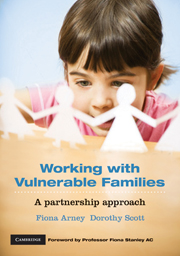Book contents
- Frontmatter
- Foreword
- Contents
- List of figures, tables and boxes
- Contributors
- Acknowledgements
- Introduction
- Chapter 1 Think child, think family, think community
- Chapter 2 Family strengths: an international perspective
- Chapter 3 Harnessing ‘resilience’ when working with children and families
- Chapter 4 Working within and between organisations
- Chapter 5 Family-centred practice in early childhood settings
- Chapter 6 Sustained nurse home visiting with families of Aboriginal children
- Chapter 7 Including fathers in work with vulnerable families
- Chapter 8 Parenting in a new culture: working with refugee families
- Chapter 9 Responding to parents with complex needs who are involved with statutory child protection services
- Chapter 10 Engaging family members in decision making in child welfare contexts
- Chapter 11 Supporting parents whose children are in out-of-home care
- Chapter 12 Using evidence-informed practice to support vulnerable families
- Chapter 13 Spreading promising ideas and innovations in child and family services
- Index
Chapter 9 - Responding to parents with complex needs who are involved with statutory child protection services
- Frontmatter
- Foreword
- Contents
- List of figures, tables and boxes
- Contributors
- Acknowledgements
- Introduction
- Chapter 1 Think child, think family, think community
- Chapter 2 Family strengths: an international perspective
- Chapter 3 Harnessing ‘resilience’ when working with children and families
- Chapter 4 Working within and between organisations
- Chapter 5 Family-centred practice in early childhood settings
- Chapter 6 Sustained nurse home visiting with families of Aboriginal children
- Chapter 7 Including fathers in work with vulnerable families
- Chapter 8 Parenting in a new culture: working with refugee families
- Chapter 9 Responding to parents with complex needs who are involved with statutory child protection services
- Chapter 10 Engaging family members in decision making in child welfare contexts
- Chapter 11 Supporting parents whose children are in out-of-home care
- Chapter 12 Using evidence-informed practice to support vulnerable families
- Chapter 13 Spreading promising ideas and innovations in child and family services
- Index
Summary
Learning goals
This chapter will enable you to:
Understand some of the characteristics of families who become involved with statutory child protection services
Understand some of the barriers to working collaboratively to assist families with complex problems who are involved with statutory child protection services
Recognise how intersectoral collaboration can support families with complex problems who are involved with statutory child protection services
Gain knowledge of how a program designed to work with families experiencing mental health problems and child protection concerns can overcome the barriers to collaborative work with families with complex needs.
Introduction
Inter-agency or inter-professional conflict is worse in bad cases, what happens is you see the other person as having the solution, you can't fix it, so you imagine they can fix it, so you blame them for not fixing it and then get angry… I could see that all over the place.
– Staff member interviewed for the evaluation of the Mental Health Liaison ProjectMental health is one issue…child is another issue…issues bounce back and clash each other… [The child protection service] needs to take mental illness seriously, serious things could happen, [the child protection service] need to be more active in connecting people to services, get people's mental health stable because the concern is for the children. [The child protection service] need to take more steps to help families [in this situation]. […]
- Type
- Chapter
- Information
- Working with Vulnerable FamiliesA Partnership Approach, pp. 187 - 208Publisher: Cambridge University PressPrint publication year: 2010
- 3
- Cited by



